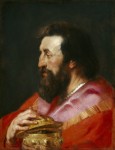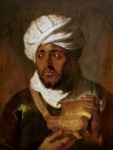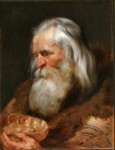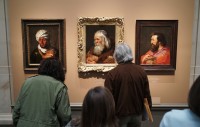 Individual portraits of the Three Wise Men painted by Peter Paul Rubens in 1618 are back together for the first time in 130 years at the National Gallery of Art in Washington, D.C. The three works, uniquely intimate bust views of the Biblical personages, are normally separated by many miles and one large ocean. Melchior, also known as the Assyrian King, is part of the permanent collection of the NGA while Gaspar, also known as the Oldest King, belongs to the Museo de Arte de Ponce near San Juan, Puerto Rico, and Balthasar, the Moorish or Young King, is owned by the Plantin-Moretus Museum in Antwerp, Belgium. Melchior cannot leave the NGA by the terms of a bequest, so this is a unique opportunity to see all three of the original paintings together.
Individual portraits of the Three Wise Men painted by Peter Paul Rubens in 1618 are back together for the first time in 130 years at the National Gallery of Art in Washington, D.C. The three works, uniquely intimate bust views of the Biblical personages, are normally separated by many miles and one large ocean. Melchior, also known as the Assyrian King, is part of the permanent collection of the NGA while Gaspar, also known as the Oldest King, belongs to the Museo de Arte de Ponce near San Juan, Puerto Rico, and Balthasar, the Moorish or Young King, is owned by the Plantin-Moretus Museum in Antwerp, Belgium. Melchior cannot leave the NGA by the terms of a bequest, so this is a unique opportunity to see all three of the original paintings together.
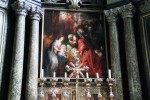 Rubens created the Three Magi on commission from Antwerp printing magnate Balthasar I Moretus after having painted the Adoration of the Magi the year before for the Church of St. John in Mechelen. Indeed there are marked similarities in the depictions of the Three Kings in the Adoration and in the ones he made for Moretus, but the individual portraits take a much more personal approach, starting with the fact that they’re in separate paintings at all when they whole point of them in terms of Christian iconography is for them to be together. There’s a reason for this.
Rubens created the Three Magi on commission from Antwerp printing magnate Balthasar I Moretus after having painted the Adoration of the Magi the year before for the Church of St. John in Mechelen. Indeed there are marked similarities in the depictions of the Three Kings in the Adoration and in the ones he made for Moretus, but the individual portraits take a much more personal approach, starting with the fact that they’re in separate paintings at all when they whole point of them in terms of Christian iconography is for them to be together. There’s a reason for this.
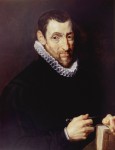 Balthasar Moretus was head of the Officina Plantiniana (Plantin Press), a printing company founded by his grandfather Christophe Plantin which was the largest publisher in Europe during the 16th and 17th centuries. He had been close friends with Rubens since they were schoolkids and once he and his brother became heads of the company after their father’s death in 1610, Moretus regularly commissioned Rubens to make illustrations and title pages for Officina publications. He also commissioned 19 portraits of friends and family including ones of his deceased father and grandfather.
Balthasar Moretus was head of the Officina Plantiniana (Plantin Press), a printing company founded by his grandfather Christophe Plantin which was the largest publisher in Europe during the 16th and 17th centuries. He had been close friends with Rubens since they were schoolkids and once he and his brother became heads of the company after their father’s death in 1610, Moretus regularly commissioned Rubens to make illustrations and title pages for Officina publications. He also commissioned 19 portraits of friends and family including ones of his deceased father and grandfather.
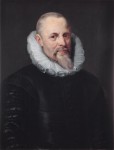 The Three Magi were an extension of those family portraits. Balthasar’s father Jan I Moretus had started at Plantin Press as an assistant when he was 15 years old and worked his way up the ladder to become Christophe Plantin’s indispensable right hand man. After his marriage to Plantin’s second daughter Martina, who ran a successful lace and linen business of her own, he became Plantin’s son-in-law and presumptive successor too. In a letter to his father, Jan explained that Moretus was the Latinized version of his last name Moerentorf and that he had chosen it as a reference to “Morus,” the Moorish king who was one of the Three Magi. He placed the king and the Star of Bethlehem on his insignia along with the motto “ratione recta” (“right reason”) because he held the star to be a symbol of reason.
The Three Magi were an extension of those family portraits. Balthasar’s father Jan I Moretus had started at Plantin Press as an assistant when he was 15 years old and worked his way up the ladder to become Christophe Plantin’s indispensable right hand man. After his marriage to Plantin’s second daughter Martina, who ran a successful lace and linen business of her own, he became Plantin’s son-in-law and presumptive successor too. In a letter to his father, Jan explained that Moretus was the Latinized version of his last name Moerentorf and that he had chosen it as a reference to “Morus,” the Moorish king who was one of the Three Magi. He placed the king and the Star of Bethlehem on his insignia along with the motto “ratione recta” (“right reason”) because he held the star to be a symbol of reason.
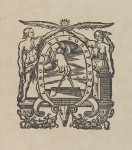
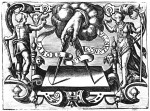 He carried that theme into the family nomenclature when he and Martina named three of their 10 children after the Magi. Balthasar, obviously, was one of the three. When he became head of the Platin Press he took a page out of his father’s book, no pun intended, put the Star of Bethlehem into the company’s golden compass printer’s device and adopted the motto “stella duce” (“with the star as guide”). The Three Magi Rubens painted for him, therefore, were avatars of the brothers, the family and its vocation on top of their religious meaning.
He carried that theme into the family nomenclature when he and Martina named three of their 10 children after the Magi. Balthasar, obviously, was one of the three. When he became head of the Platin Press he took a page out of his father’s book, no pun intended, put the Star of Bethlehem into the company’s golden compass printer’s device and adopted the motto “stella duce” (“with the star as guide”). The Three Magi Rubens painted for him, therefore, were avatars of the brothers, the family and its vocation on top of their religious meaning.
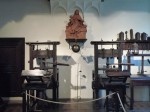 Many of the portraits Rubens painted for the publishing dynasty still hang on the wall of the main gallery of Plantin-Moretus Museum, a museum dedicated to the Plantin Press and Plantin-Moretus families that is located in the Renaissance-style palace that housed both the family and the business from the 16th century through the late 19th. The lavishly decorated building and its extraordinary contents — Flemish Baroque Old Master paintings, rare books, the two oldest surviving printing presses in the world (from around 1600), complete sets of punches, dies, matrices, type in multiple languages and an almost unbroken archive of the Plantin Press business records from 1555 to 1876 — are on the UNESCO World Heritage list.
Many of the portraits Rubens painted for the publishing dynasty still hang on the wall of the main gallery of Plantin-Moretus Museum, a museum dedicated to the Plantin Press and Plantin-Moretus families that is located in the Renaissance-style palace that housed both the family and the business from the 16th century through the late 19th. The lavishly decorated building and its extraordinary contents — Flemish Baroque Old Master paintings, rare books, the two oldest surviving printing presses in the world (from around 1600), complete sets of punches, dies, matrices, type in multiple languages and an almost unbroken archive of the Plantin Press business records from 1555 to 1876 — are on the UNESCO World Heritage list.
 The Moretus family thankfully kept most everything that crossed the transom and, after Balthasar I expanded the house and annexed the printing shop to it, made few changes to the property until Edward Moretus sold the company to the city of Antwerp in 1876. Within a year it was a museum for the public to enjoy the gorgeousness of the home (never mind the priceless art on the wall, the woodwork is INSANE) and the utilitarian beauty of the printing offices. The Three Magi were long gone by then, however. The family had sold the Three Kings to Graaf Van de Werve de Vosselaer of Antwerp in 1781. They were still together until they were dispersed at the Paris auction of the John William Wilson collection in 1881.
The Moretus family thankfully kept most everything that crossed the transom and, after Balthasar I expanded the house and annexed the printing shop to it, made few changes to the property until Edward Moretus sold the company to the city of Antwerp in 1876. Within a year it was a museum for the public to enjoy the gorgeousness of the home (never mind the priceless art on the wall, the woodwork is INSANE) and the utilitarian beauty of the printing offices. The Three Magi were long gone by then, however. The family had sold the Three Kings to Graaf Van de Werve de Vosselaer of Antwerp in 1781. They were still together until they were dispersed at the Paris auction of the John William Wilson collection in 1881.
 The old king (Gaspar) and the middle-aged king (Melchior) went to the United States. Gaspar returned to Europe in 1962 where it was sold at a Sotheby’s auction in London. The Museo de Arte de Ponce was the buyer. Melchior was donated to the National Gallery of Art in 1943 by collector Chester Dale who bequeathed almost his entire art collection to the museum in 1962. Balthasar had a more troubling road. Somehow he found his way into the collection Hermann Goering amassed from the confiscation, coercive sale and outright theft of Jewish property and looting of occupied territories during the war. After that ugly spell, Balthasar became part of a private collection in Brussels before eventually being reacquired by the Plantin-Moretus Museum.
The old king (Gaspar) and the middle-aged king (Melchior) went to the United States. Gaspar returned to Europe in 1962 where it was sold at a Sotheby’s auction in London. The Museo de Arte de Ponce was the buyer. Melchior was donated to the National Gallery of Art in 1943 by collector Chester Dale who bequeathed almost his entire art collection to the museum in 1962. Balthasar had a more troubling road. Somehow he found his way into the collection Hermann Goering amassed from the confiscation, coercive sale and outright theft of Jewish property and looting of occupied territories during the war. After that ugly spell, Balthasar became part of a private collection in Brussels before eventually being reacquired by the Plantin-Moretus Museum.
The Three Kings will be together again at the National Gallery of Art from March 17th through July 5th, 2015.
